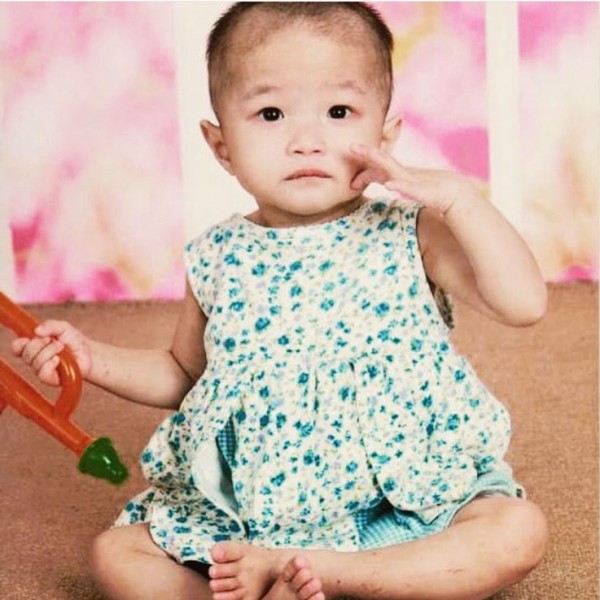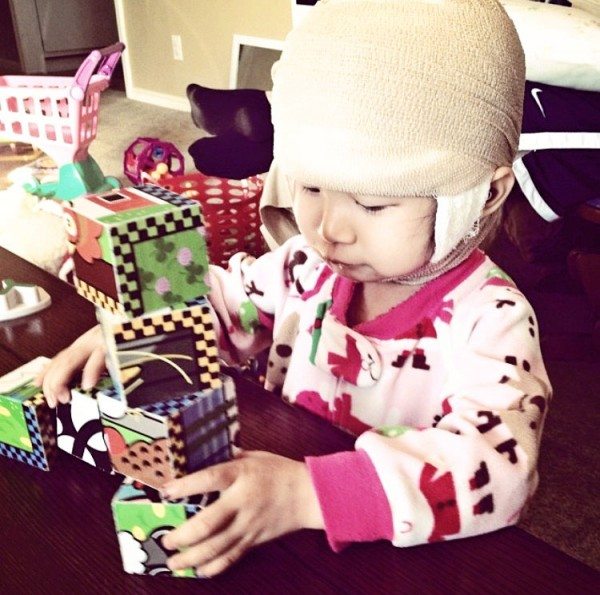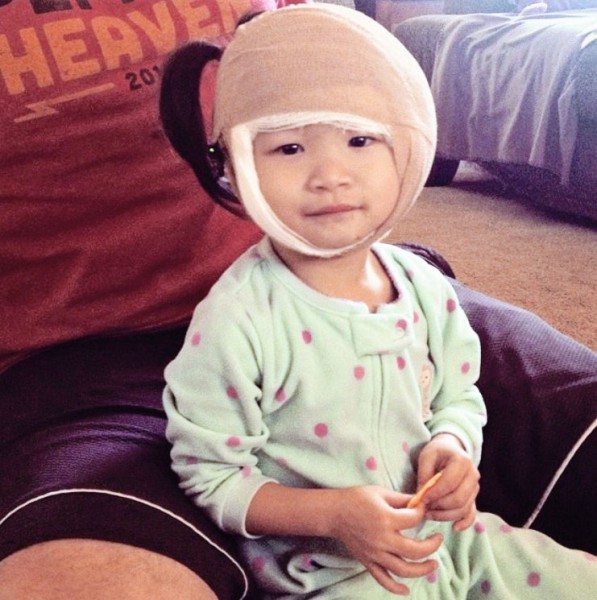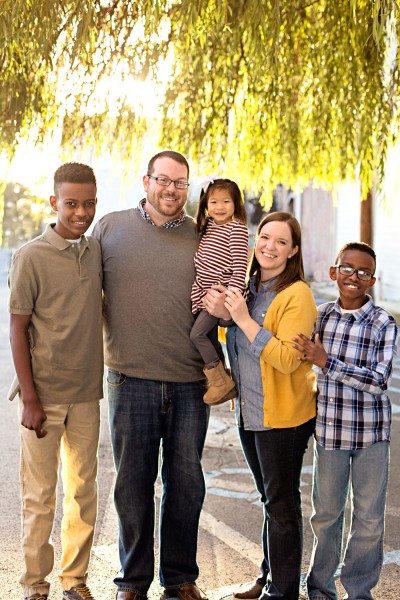When we started the adoption process for the second time, we knew things would look differently. Adopting a child through the Special Needs program in China was a huge step of faith for us and we had no idea what the next few months or even years would look for our family. While we were very excited to add to our family, there was definitely a level of fear as we entered a very unknown process.
At some point early in our process, I asked my husband what he thought about specifically pursuing a child with hearing loss. Neither of us had any special skills that would make us great parents to a child with hearing loss. No experience. What was a hearing aid? Didn’t know sign language. Nothing. We had already filled out that dreaded sheet of paper indicating which special needs we would consider, hearing loss being one of the many, but still the Lord had placed this on my heart. We ended up deciding to let nature take its course, not limit the Lord to a child with hearing loss and waited patiently for a referral.
Imagine our surprise at an early morning phone call from our social worker with the file of a 16-month-old baby girl from Huazhou, China… who was profoundly deaf. I’ll be honest, she was ours before I ever read a word about her or laid eyes on a picture! But I did let my husband have a say in it before we officially said “YES”!
We spent the next four months learning all we could about children with hearing impairments, the deaf community, and what we could possibly expect. I have worked with children with special needs most of my life and had many connections in the early intervention world. I made many phone calls to my therapist friends and picked their brains about what kind of things we needed to know about bringing home a profoundly deaf toddler. I searched every website I could get my hands on and joined many Facebook groups for parents of children with hearing loss to learn about the day to day issues these parents were dealing with. (But please remember to take everything said in Facebook Land with a grain of salt…. while I learned a lot, there’s also a ton of info out there that is just plain wrong!)
To say I was overwhelmed before I even held my daughter for the first time was an understatement.
One of the best things that happened before we even accepted our daughter’s referral was being connected with an audiologist at a local clinic who was able to review Ellie Kate’s file from China and give us some idea of what to expect before she even came home. She answered every single question I had (and there were a lot), honestly and openly, giving me best and worst case scenarios. She was able to look at the hearing tests that had been done in China and tell us that, based on those tests, our sweet Ellie Kate had bilateral profound sensorineural hearing loss which was later confirmed once stateside.
Once Ellie Kate was home we spent a few weeks just getting used to our new normal (and getting over that dreaded jet lag). Then we jumped into figuring out the best way to help her. It was very evident that Ellie Kate was pretty severely delayed across the board. But most of those delays were either from her hearing loss or environmental, due to her time in the orphanage. She was 20 months old, only 13 pounds, obviously not talking, barely sitting up, and taking nothing but bottles when she was placed in our arms.
We determined that our main concerns were focusing on her learning to listen and eating. So referrals were made through our state’s early intervention program and she began seeing a developmental interventionist who focused on working with children with hearing loss and also an occupational therapist to help us with some pretty significant feeding issues. Physical therapy was also recommended, but in our effort to keep her world small and have as few folks in contact with her as possible while we worked on bonding and attachment, we declined PT. She was quickly motoring through those physical milestones as she was given the freedom to explore her new home and had mastered crawling, cruising, walking, and running by her 2nd birthday.
Occupational therapy was also short lived as she eventually figured out all this food we were putting in front of her was actually really yummy and went in her mouth instead of tossed on the floor. She never really exhibited too many sensory issues with food, it was just a lack of exposure and not knowing what to do with food once it was in her mouth. Once sure figured out how to chew and swallow something more than milk, she has never stopped and is a great eater. We still have trouble with meat, but she will eat almost anything else we’ve put in front of her.
Our next steps were figuring out how to address her hearing loss. After an initial appointment and sound booth test with pretty much no response from Ellie Kate, we began the steps towards cochlear implants for her. In the meantime, she was fitted with loaner hearing aids. Many insurance companies will require a trial with hearing aids prior to approving a cochlear implant to prove that the child can’t achieve/hear speech sounds needed to learn speech without further assistance, but this also began to stimulate Ellie Kate’s auditory nerves – something that hadn’t been done at all in her short life.
One important question I had in the beginning: What’s the difference in a hearing aid and a cochlear implant? While both could be used for the type of hearing loss Ellie Kate had, a hearing aid amplifies sound and a cochlear implant is a surgically implanted device that turns sounds into electrical energy that stimulates your auditory nerve. Hearing aids typically are more suited for a person with mild to moderate hearing loss. And cochlear implants are used for individuals with severe to profound hearing loss. Ellie Kate fell into the category of profound hearing loss and really received little sound benefit from her time with her hearing aids.
An appointment was made with an ENT/surgeon who specialized in cochlear implants, and we were scheduled for several tests. They sedated Ellie Kate and completed an ABR (auditory brainstem response) to get a more accurate picture of her level of hearing loss and a MRI and CT scan to check the anatomy of her ears. Her first ABR showed fluid in her ears, which led us to place tubes and repeat her ABR. The tubes did nothing to change her level of hearing in the end, but ensured that those little ears stayed relatively healthy and infection free during this whole process. Her MRI and CT came back with almost perfect results. Besides everything just being much smaller than anticipated for a child her age, the anatomy of her ear was great, her auditory nerve was present and intact and she made a perfect candidate for a cochlear implant!
We scheduled her surgery and on December 23, 2013, Ellie Kate had her first cochlear implant placed in her right ear. She was almost 27 months old. This part of the process was placing the internal device that include the electrodes that were inserted into her cochlear to help her hear. Even though it seemed nuts to me, this surgery was done as an outpatient procedure and after a long day at the hospital we were sent home that evening with a sleepy and slightly cranky toddler who looked a little like a human q-tip. She kept her fancy “hat” for about 3 days until we removed it per the surgeon’s instructions to find a very clean incision, neatly hidden behind her little ear. Her face, eyes and ear were pretty swollen the first few days, but other than some longer than normal naps for a few days, she bounced back to her old self. We even traveled (surgeon approved) to visit family for the holidays several days later with no problems. Ellie Kate just sported her fancy footie pajamas instead of her pretty Christmas dresses to keep from pulling things over her head while her incision healed, but that was a small price to pay for what was to come for her.
She had a follow up appointment with her surgeon the next week and on January 3, 2014 we visited her audiologist where the external piece of her cochlear implant was activated and she heard for the very first time! She didn’t give us one of those famous YouTube worthy responses, but watch those eyes….she knew something was up!
Now was when the real work began! She was now seeing a speech therapist, was in a weekly playgroup at the local deaf/oral school with a Teacher of the Deaf, and continued to see her developmental interventionist to keep catching up on her overall developmental delays. Ellie Kate had never really heard sound and had to be taught how to listen and respond. We spent a LOT of time just making a whole lot of noise and training her to respond! And gradually we began to introduce sounds and words to progress towards talking.
She did well wearing her implant from the beginning, but had trouble adjusting to sound each time we would put it on in the mornings and after nap times. There were many tears shed (hysterics, really), but we took it in stride and gradually her response to sound went from scary to something she was asking for before I could even get her out of the bed in the mornings.
We also had frequent appointments with her audiologist whose job was to continuously check her hearing, ensure she was hearing at her absolute best and make any adjustments needed to her cochlear implant. These appointments were called “mappings” and included sound booth tests and hooking our “ear” up to the computer to check things out. Different programs were made that were created just for Ellie Kate on her implants and during the time between her appointments, we were able to gradually increase the volume at which she was hearing to ensure that we didn’t overwhelm her with too much noise too fast. Ellie Kate always did great as we progressed through her programs and we quickly had her hearing at her maximum level.
After having her right ear implanted, we soon began talking with her audiologist and surgeon about having the left ear implanted as well. God gave us two ears for a reason and we knew that being able to hear with both ears would only help with her speech development and other things like localizing sounds. About a year later, on January 19, 2015 at 3 years and 3 months, she had her second implant placed in her left ear. The process was very similar and on February 3rd, we introduced Ellie Kate to surround sound hearing!
Ellie Kate’s progress has been steady, but slow. She is a great listener and her receptive language has increased by leaps and bounds, especially since her second implant. Her speech is still very much delayed, but she is currently having a little language explosion and we hear new words from her almost daily! She is beginning to use single words to express her wants and needs and as with most kids, has perfected “no” and “mine”. Patience is key around here. I have to remind myself that even though she is 4 years old, she’s been hearing less than 2 years so I can’t expect her language skills to be at a 4 year old level.
She graduated from home-based early intervention at 3 and has been attending our local deaf/oral school several days a week since then. She is currently in her second year of the 3 year old class (perks of a late birthday!) and still sees her speech therapist several times a week. Having her at a school where the teachers are trained specifically to work with children with hearing loss is something I can’t duplicate at home and has been great for Ellie Kate.
I am blown away daily by the technology that allows Ellie Kate to hear. It’s crazy to think about the delicate, but powerful device that has replaced her natural hearing and allows her to go from silence to hearing almost everything! Unfortunately that worry in the back of your Mommy brain that all this is technology and sometimes technology fails has rang true for us over the last few weeks. Due to a “device migration”, very uncommon, I was assured, we will be having surgery at the end of the month to hopefully re-secure or possibly replace her left implant. We aren’t 100% sure why, but her internal piece has slowly moved itself from its original placement and is migrating down her neck (for a lack of a better way to explain it). She has been unable to wear the external part of her cochlear implant during this time, which means she’s down to hearing with one ear. We fortunately have a great team supporting us and they have done everything possible to make this hiccup in Ellie Kate’s hearing journey as painless and as easy as possible.
A few extra notes…
Insurance: Another question I get often is…”Does insurance cover that??” And fortunately, I can reassure them that it does! We did make sure that our insurance policy covered audiology services and speech therapy from the beginning. I have run into a few folks that unfortunately don’t have coverage for audiology services. The past few years we have actually been on a high-deductible plan through my husband’s employer. Planning ahead and doing the math, we knew that this was going to be cheaper for us in the long run than your typical 80%/20% plan. We have hit our out-of-pocket maximum the last few years as well with her surgeries and other appointments, which is scary, but has the added benefit of everything being paid at 100% once we get to that point. Cochlear implants are expensive, the parts are expensive and it’s very unnerving to receive that statement for the surgery that totals nearly $200,000, but that’s what warranties and insurance policies are for! Do your homework and know what your policy covers. And take advantage of foundations or groups willing to assist with medical expenses. Many children’s hospitals are more than willing to work with you on the financial side of things and want, just like you, the best for your child.
Genetic Testing: At the beginning of this year, we started the process of genetic testing. There are several syndromes that are connected to hearing loss as well as different genes that can cause hearing loss. While knowing the cause of her hearing loss wouldn’t change anything for her or us, not having any family information led us to do a little investigating to see what we could find out. After a visit with a genetic counselor and doctor and a whole lot of blood work, we unfortunately came up with no answers as to the origin of her hearing loss.
Sign Language: Many people ask if we know sign language and we do use signs with Ellie Kate, but what we know has all been self-taught (despite the ASL class I took in high school) and is always accompanied with a verbal word to reiterate her listening skills. Personally, I would like our whole family to continue to learn sign and I want Ellie Kate to be able to sign as well. ASL is just another language and could benefit our family in many ways!
Daily Life: We get a lot of questions about how Ellie Kate’s special needs impacts our family dynamics and our other children. Having a child who is deaf and wears cochlear implants has done almost nothing to change our day to day life. It was honestly a bigger change adding a third child (parents now outnumbered) to the mix! Her hearing loss doesn’t slow her or us down. We are still very active in all the same activities we did before Ellie Kate joined our family….church, school, sports, playdates, etc. She goes swimming and plays in the sprinkler. She jumps on the trampoline. She watches movies with us on family movie night. She loves (LOVES!) music. She dances and spins. She runs and flips and climbs. And if her “ears” fall off, we just stick them back on! Yes, there are more doctor appointments. Yes, we have weekly therapy appointments. Yes, I now drive 45 minutes one way to get to the best school for her. But it’s all just part of life now and is what we do to make sure she is thriving. She has her own little bag of cochlear implant supplies that goes with us when we travel. And Mommy has had to learn to remember to bring along extra batteries for those all-day outings!! Because she lets me know when she loses sound to one of her ears!
Our journey to help Ellie Kate hear is similar to many others, but each step has been special and precious to us. If you have any questions, feel free to contact me at janacook20@gmail.com. Much of her journey is also documented HERE, but I’m giving you a fair warning that I haven’t updated it in a while!
For more information about hearing loss, check out these great resources…
Listening and Spoken Language Learning Center
My Baby’s Hearing
Hands and Voices
My Child Without Limits
– guest post by Jana





























Leave a Reply